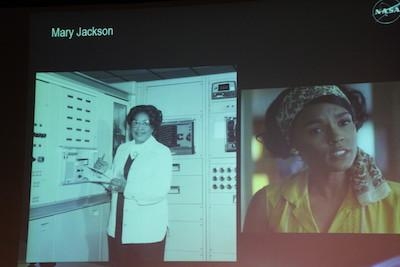NASA Historian Tells Story Behind 'Hidden Figures'
By Maxine Scheer
During AirVenture 2017, an overflow crowd lined up at the EAA Skyscape Theatre for a presentation by NASA Chief Historian William (Bill) P. Barry. The topic, an overview of NASA Langley's thirty-plus-year employment of human computers and comparison of historic facts to the storyline of the Oscar nominated film, "Hidden Figures'.

Dr. Barry noted that the idea behind the movie originated with a manuscript written by Margot Lee Shetterly and picked up by Twentieth Century Fox. The Oscar nominated film was completed before Ms. Shetterly published her book, "Hidden Figures". NASA officials were contacted by the movie producers, which prompted the compilation of historic materials for the movie. This included files from the predecessor of NASA, the National Advisory Committee for Aeronautics (NACA).
NACA engineers generated significant amounts of data in their aeronautical research missions that needed to be calculated. "Before electronic computers, calculating was tedious and considered women's work', noted Barry. In a memo dated 1942, NACA responded to Curtis Wright inquiries on the success of computing pools and noted the computers were more accurate and more efficient than men. "Women computers can get more done in a morning then the men can complete in an entire day." At that time, an estimated 85 computers were at Langley, which employed over 1,000 people.
NACA's needs for more data crunching increased as aircraft produced during WWII came through Langley for "cleanup testing". The supply of computers, predominantly white women, did not meet demand. It was out of necessity that NASA looked to the African American community where they could find talented women employed predominantly as teachers in local school districts. In June of 1943, five African American women were chosen in what he described as "an experiment", quickly acknowledged as a great success as many of these women had math degrees, teaching experience, and were significantly more qualified than existing staff. The African American women also had a network of similarly talented friends, which was integral to future recruitment.

In comparing the movie to historic facts, Dr. Barry pointed out that the movie condensed the timeline to two years versus the thirty-year period where African American women computers were employed at Langley. Many of the issues and events featured in the film were accurate, but were condensed to coincide with the Civil Rights movement and proximity to John Glenn's 1962 orbital flight on Friendship Seven.
For example, Dorothy Vaughan did have to wait nearly two years for her promotion, but this occurred in 1952, versus 1962 as portrayed in the movie. Mary Jackson, hired in 1951, worked for two years as a computer. Her potential was recognized as she was pulled off to work on the Supersonic tunnel. It was true that she petitioned a court to take University of Virginia night classes at Hampton High School, a white-only facility, but this occurred around 1952-53, nearly ten years before the time portrayed in the movie, providing a deeper understanding of her courage and tenacity. Mary completed the courses, earned a Masters in aeronautical engineering, awarded a promotion, and in 1958 became NASA's first black female engineer.
Katherine Goldman was hired by NACA in 1953, and within 2 weeks was pulled out to work in flight research, attributed to her exceptional skills and enthusiasm. One of her first projects was on "a plane that fell out of the sky". Dr. Barry also attributes to Katherine what we know about wingtip vortices and altitude separations used today.
Dr. Barry noted the movie did go a bit overboard on scenes with John Glen. We carefully confirmed Glen did say "have the girl check the numbers and if she's good, I'm ready to fly". But not within the last-minute timeframe depicted in the movie. Katherine prepared these calculations long before the mission, and was given co-authorship of the paper, even though she did all the work. Katherine also did calculations to confirm the accuracy of the new IBM mainframes used at NASA. "Her calculations took one and a half days and generated precisely the same numbers."
Another difference is the role portrayed by actor Kevin Costner, which did not exist at NACA.
Organizationally, Katherine was assigned under layers of a complex organization that presented a challenge to portray in a major motion picture. According to Dr. Barry, Katherine Goldman used the restrooms where she worked, and did not run to another building to use segregated facilities.

Barry described a lack of attention on the history of these women to three factors. First, the work they were doing was classified, second was what Barry described as the modesty of the WWII generation, and last was privacy. "They went from earning $850 a year as a school teacher to $2,000 a year as a starting salary at NACA, and didn't want to draw attention to themselves in fear of retaliation from the segregated community in which they lived.
"We at NASA understand a diverse organization benefits everyone, but we still have work to do."
Barry estimates of the 18,000 people working at NASA, only one third are women. Approximately 1,200 are African American women, and less than 50% of those are engineers.
Barry noted NASA officials were surprised by the success of "Hidden Figures' and the awareness the Oscar nominated film has raised of "modern" figures of women at NASA. NASA has created a website, "Modern Figures', that includes educator toolkits.
(Staff images)
 ANN's Daily Aero-Term (04.24.24): Runway Lead-in Light System
ANN's Daily Aero-Term (04.24.24): Runway Lead-in Light System ANN's Daily Aero-Linx (04.24.24)
ANN's Daily Aero-Linx (04.24.24) Aero-FAQ: Dave Juwel's Aviation Marketing Stories -- ITBOA BNITBOB
Aero-FAQ: Dave Juwel's Aviation Marketing Stories -- ITBOA BNITBOB Classic Aero-TV: Best Seat in The House -- 'Inside' The AeroShell Aerobatic Team
Classic Aero-TV: Best Seat in The House -- 'Inside' The AeroShell Aerobatic Team Airborne Affordable Flyers 04.18.24: CarbonCub UL, Fisher, Affordable Flyer Expo
Airborne Affordable Flyers 04.18.24: CarbonCub UL, Fisher, Affordable Flyer Expo





